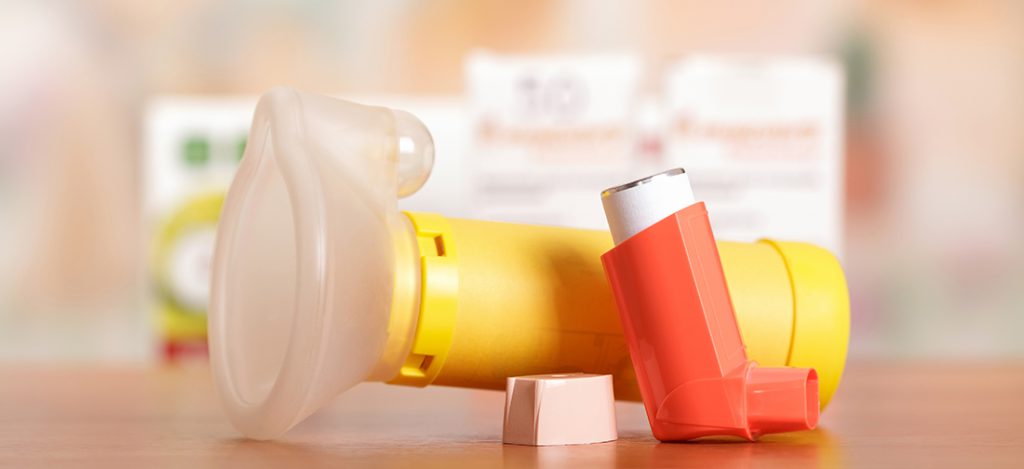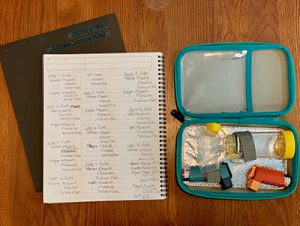Prepare Your Health: Falling Into Asthma
Posted on by
Fall is a busy time. It marks peak hurricane season and the start of cold and flu season. Fall is also one of the busiest months for asthma attacks. Throughout autumn, our home is on high alert because of our children’s history of asthma, and the likelihood of them having an increased number of asthma episodes due to one or all of these environmental triggers.
Asthma is a serious, but common lung condition, and one of the most common long-term diseases of children, including my own.
This fall my daughter, Charlotte, will be 4 years-old, and Zachary will be just shy of 2 years old. Both were diagnosed with asthma at an early age due to repeated episodes of chest tightness, coughing, shortness of breath, and wheezing.
Charlotte’s asthma is mild, and her need for medical intervention is rare; however, Zachary’s asthma is more severe. Each morning and every night it’s a game of hide and go seek, as we struggle to give him his controller medication, allergy medicine, and suction out his nose. All of which is “torture” for him, but medically necessary to prevent the common cold and flu viruses from taking control, and landing him in the Pediatric Intensive Care Unit (PICU). In an attempt to soothe his angst, we let him hold a favorite toy, we stroke his hair, and play his favorite song … Billy Joel’s Uptown Girl.
Parents of and people with asthma are on alert all of the time, not just in the event of an episode or a disaster. Our family has become hypersensitive to any cold or virus that Charlotte and Zachary pick up, because we know that these are triggers for both of them. As a means for minimizing the stress associated with this, we’ve taken steps to improve our personal health preparedness.
Know Your Personal Needs
 Know what works for your family! In our home, Zachary has a medical alert bracelet that he wears when we travel, participate in new activities, or when he’s with a caretaker that is not familiar with his asthma diagnosis and triggers. Due to his young age, the medical alert bracelet we chose for Zachary is made of cloth, secures with a snap, and is free of any material that may cause harm.
Know what works for your family! In our home, Zachary has a medical alert bracelet that he wears when we travel, participate in new activities, or when he’s with a caretaker that is not familiar with his asthma diagnosis and triggers. Due to his young age, the medical alert bracelet we chose for Zachary is made of cloth, secures with a snap, and is free of any material that may cause harm.
On the inside of the bracelet is his name, medical concern, necessary actions needed in an emergency, and emergency contact information. Depending on your child’s age, different medical alert bracelets may be appropriate.
In addition to a medical alert bracelet, we maintain certain medical equipment and supplies in our home at all times. These supplies and equipment include:
- Medical equipment
- Nebulizer
- Infant/Pediatric/Adult Handheld Pulse Oximeter
- Digital thermometer
- Medical equipment and supplies specific to each child (not shared)
- Infant/Pediatric nebulizer mask
- Infant/Pediatric spacer
- Saline spray
- Nasal aspirator (Nose Frida)
- Syringes
- Baby and/or isopropyl alcohol wipes
After each use we ensure that the nebulizer, nebulizer mask, spacers, inhalers, and nasal aspirator are free of any film or build up left over from medications. Additionally, we make sure to wipe down over the counter medications that are inserted into the nostril to prevent re-introducing bacteria.
Keep Prescriptions Handy
 Before, during, and after an emergency, it is highly recommended to have an emergency supply of prescription medications, and the necessary over-the-counter medical supplies.
Before, during, and after an emergency, it is highly recommended to have an emergency supply of prescription medications, and the necessary over-the-counter medical supplies.
It’s also important to have an up-to-date list of all prescription medications, including dosage amounts and names of their generic equivalents, medical supply needs, and known allergies. Our family keeps this information, along with an Asthma Action Plan, in a folder on the kitchen table.
Additionally, we keep a notebook for Zachary that details the medications he received that day, and at what time they were last given. This ensures that anyone taking care of him in our absence has all of the pertinent information they would need in an emergency.
We also keep an emergency supply of over-the-counter medications, including pain and fever relievers, and antihistamine medicines stored in labeled, childproof containers. These containers are kept off of counters, and on the top shelf of cupboards where little hands can’t reach them.
Keep Paperwork Accessible
Collect and protect important paperwork, including health insurance cards and emergency action plans, to prepare for an emergency.
- Asthma Action Plan
- Immunization and vaccination records
- Vital records
- Personal identification
- User manuals with models and serial numbers, and contact information for the manufacturer of medical devices, such as a nebulizer.
Each of these documents can be kept in a folder similar to the one our family maintains, or they can be scanned and securely stored on a thumb-drive or cloud based server for easy access.
Find more personal health preparedness resources and recommendations at www.cdc.gov/prepyourhealth.
Thanks in advance for your questions and comments on this Public Health Matters post. Please note that the CDC does not give personal medical advice. If you are concerned you have a disease or condition, talk to your doctor.
Have a question for CDC? CDC-INFO (http://www.cdc.gov/cdc-info/index.html) offers live agents by phone and email to help you find the latest, reliable, and science-based health information on more than 750 health topics.
3 comments on “Prepare Your Health: Falling Into Asthma”
Comments listed below are posted by individuals not associated with CDC, unless otherwise stated. These comments do not represent the official views of CDC, and CDC does not guarantee that any information posted by individuals on this site is correct, and disclaims any liability for any loss or damage resulting from reliance on any such information. Read more about our comment policy ».
Though the author refers to her children, it is also important for adults with Asthma to be very careful during this time of year. As a nurse, I have witnessed many adult’s asthma become complicated by contracting the flu. I do recommend the flu vaccine if you suffer from any form of respiratory condition. Remember, the flu vaccine does not prevent you from contracting the flu, however, the symptoms are less severe. Therefore, you should always still practice good hand hygiene. The flu can be deadly to a person with asthma, early intervention is important, get to your Dr. or hospital if you think you may have contracted the flu.
As a nurse and fellow sufferer of asthma, I think the advice in this post is excellent. In addition to the advice given in this blog post I would also suggest packing an asthma travel kit any time you have to go out of town. I have personally been on vacation, developed bronchitis and desperately needed my nebulizer that was at the time several states away. Because home nebulizers can be bulky and heavy, I highly suggest investing in a small, portable travel nebulizer. These can be purchased for around $50 to $60 and are small enough to fit in the palm of your hand. Many different brands and models are available for purchase on Amazon.com.
I began suffering from asthma four years ago and as a nurse and a mother of a child that suffered from asthma this blog has great information on how to handle care and to keep necessary information with in arms reach. Along with everything that this blog provided I would add that in each car that my husband and I share we have a travel bag of medications, personal care and documents that may be needed. The weather change can happen very fast or an allergic reaction to a food that my son or I have eaten, so I have a journal of triggers that we should avoid and we update it each month, this may help someone narrow down triggers if they are unsure.